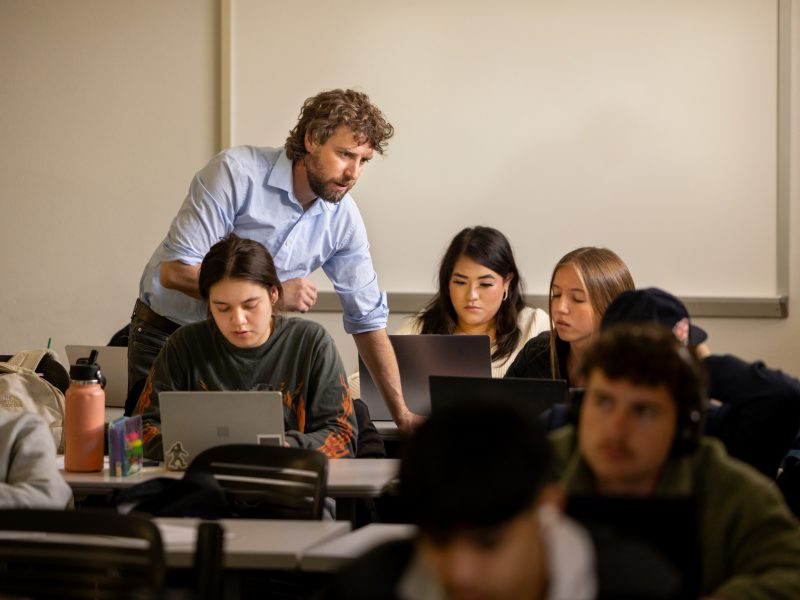Overview
NAU encourages faculty to stay informed about the latest advancements in artificial intelligence, as these tools are likely to shape the future of education and professional fields. It’s essential to understand both the strengths and limitations of AI, and to guide students in using AI as a supportive resource rather than a substitute for critical thinking and learning.
Guidelines
Provide and discuss clear syllabus policy statements that define permitted and prohibited use in your courses; developed in collaboration with our instructional designers, we offer sample syllabi statements to use as a starting point in offering guidance to students, which may be modified to fit specific course or assignment needs. Unauthorized uses of GenAI, as defined by the instructor, may constitute an academic integrity violation.
Accessibility, personal concerns regarding adoption, and other barriers may cause undue burden on students. Faculty should provide a non-GenAI option for students when incorporating these tools into student assignments.
Current GenAI detector technologies, including NAU’s industry-leading licensed solution Turnitin Originality, are imperfect and may return false positives and false negatives. Be cognizant that results such detectors produce cannot be considered as definitive evidence of an academic integrity violation.
There are myriad possibilities: Explore using generative AI to outline schedules and topics for new modules or lessons, or generate variations of exam questions that assess student learning. Ask students to explore a high-level topic using GenAI chatbots and report their detailed findings, create their own practice exams by generating questions on key course topics, or create and refine outlines and first drafts of writing assignments.
Applications of generative AI in professional practice abound, and these technologies have already augmented the standard toolkits in many occupations. Seek opportunities to make curricular changes that build on the changes you anticipate happening and better prepare students for the evolving professional landscape.
Transformation through Artificial Intelligence in Learning (TRAIL)
The Transformation through Artificial Intelligence in Learning program, launching in academic year 2024–2025 with an inaugural set of grants, aims to support faculty in developing innovative approaches for applying AI technologies to various aspects of student learning and our broader educational enterprise.
Resources
Sample syllabi statements
All use of generative AI is permitted, with acknowledgment
This course (or assignment) allows the use of generative AI for any work submitted by students working individually or in groups as directed by class assignment instructions. When submitting an assignment that contributes toward the course grade, there is an expectation to acknowledge what content was generated by generative AI tools (e.g., AI-generated text appears in a different colored font, is quoted directly in the text, or uses an in-text parenthetical citation). If you have any questions about how to appropriately acknowledge the use of such technologies, please ask for clarification before submitting assignments.
Limited use of generative AI is permitted in specific contexts
This course (or assignment) allows for the use of generative artificial intelligence (AI) technologies as part of the research and preparation phase of the work, for example using these technologies to assist with research, generating ideas, creating summaries of topics, and developing drafts of text that are then used as an input to the work students do to generate a final assignment. In this use, students should be aware of the potential limitations of using generative AI as a tool for learning and research since information is not always reliable or accurate, and should critically evaluate the sources, methods, and outputs of generative AI systems. Any final work submitted by students that contributes toward the course grade is expected to be generated by the students themselves, working individually or in groups as directed by class assignment instructions. Submitting final work created by generative AI constitutes an academic integrity violation. If you have any questions about this policy or if you are unsure whether a particular use of generative AI is acceptable, please ask for clarification before using such technologies.
No use of generative AI tools permitted
This course (or assignment) expects that any work submitted by students that contributes toward the course grade, including all process work, drafts, brainstorming artifacts, and final work, will be generated entirely by the students themselves, working individually or in groups as directed by class assignment instructions. Any use of generative artificial intelligence tools, such as ChatGPT, constitutes an academic integrity violation.
Microsoft Copilot
NAU faculty members have access to Copilot, Microsoft’s generative AI chatbot,1 at no cost.
To log in to Microsoft Copilot, navigate to Copilot and enter your NAU credentials when prompted. Once logged in, you’ll be able to ask Copilot any questions or requests you have.
Extended licensing for Copilot
For $400 per year, extended licensing is available for Microsoft Copilot, which expands Copilot’s functionality by integrating it with your Microsoft account. You can ask Copilot to find availabilities, format Excel data for you, and more. For more information, visit ITS’ Copilot.
Protecting NAU data
When using generative AI tools, even those supported by NAU, never share any sensitive data.2 Any data above a level 2 classification on NAU’s Data Classification and Handling policy should not be shared with generative AI tools.

Additional resources
1. Microsoft Copilot is a large-language model (LLM) built on Open AI’s ChatGPT technology.
2. Level 2 data is information that is not generally available to the public. Level 2 data include information such as prospective student records, financial or budgetary data of the university, network infrastructure diagrams, architectural blueprints of university buildings, NAU usernames, and similar types of information.

